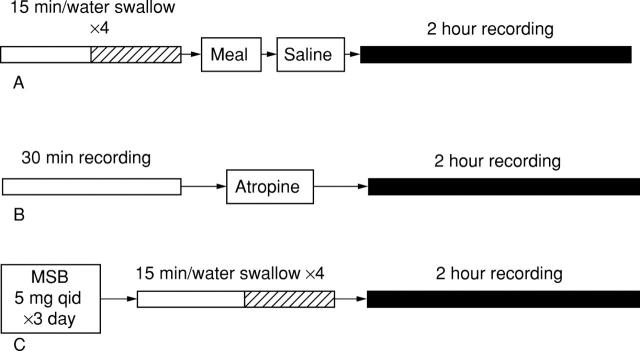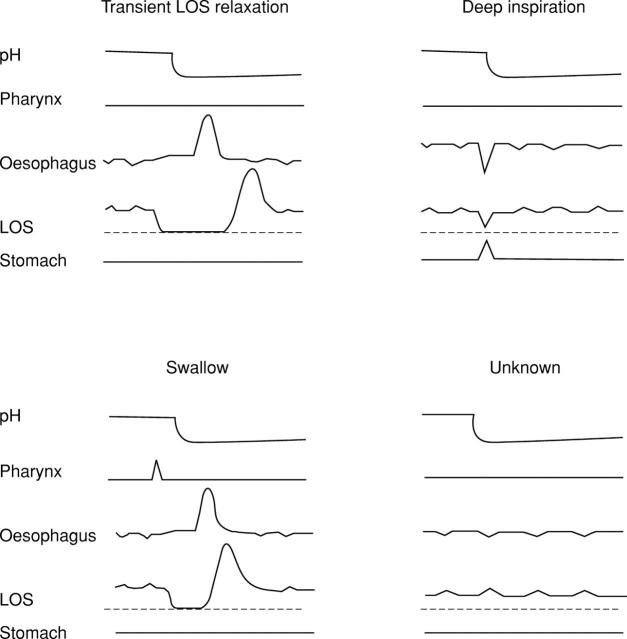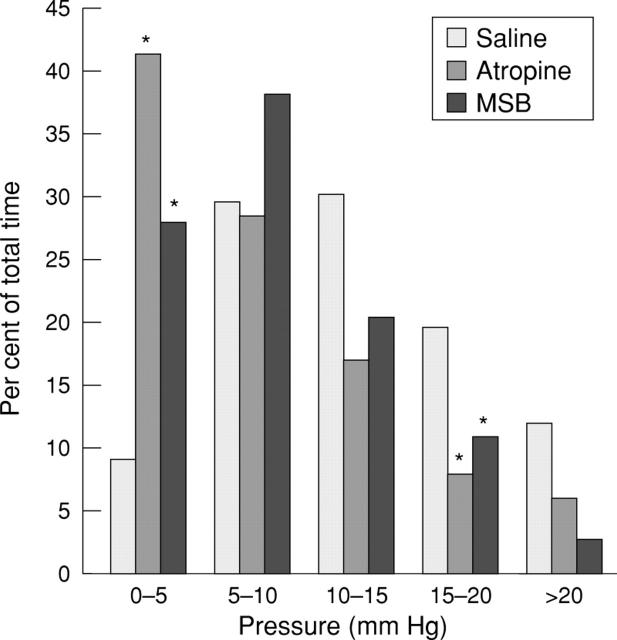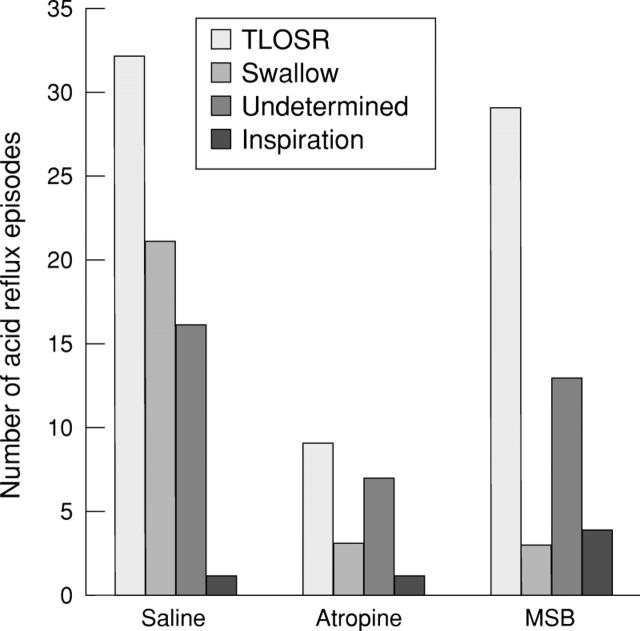Abstract
BACKGROUND—Atropine, an anticholinergic agent with central and peripheral actions, reduces gastro-oesophageal reflux (GOR) in normal subjects and patients with gastro-oesophageal reflux disease (GORD) by inhibiting the frequency of transient lower oesophageal sphincter relaxation (TLOSR). AIMS—To compare the effect of methscopolamine bromide (MSB), a peripherally acting anticholinergic agent, with atropine on the rate and mechanism of GOR in patients with GORD. METHODS—Oesophageal motility and pH were recorded for 120 minutes in 10 patients with GORD who were studied on three separate occasions. For the first two recording periods, either atropine (15 µg/kg bolus, 4 µg/kg/h infusion) or saline were infused intravenously. MSB (5 mg orally, four times daily) was given for three days prior to the third recording period. RESULTS—Atropine significantly reduced basal LOS pressure (12.6 (0.17) mm Hg to 7.9 (0.17) mm Hg), and the number of TLOSR (8.1 (0.56) to 2.8 (0.55)) and reflux episodes (7.0 (0.63) to 2.0 (0.43)) (p<0.005 for all comparisons). MSB reduced basal LOS pressure (12.6 (0.17) to 8.7 (0.15) mm Hg, p<0.005), but had no effect on the frequency of TLOSR (8.1 (0.56) to 7.5 (0.59)) and reflux episodes (7.0 (0.63) to 4.9 (0.60)) (p>0.05). CONCLUSION—In contrast to atropine, MSB has no effect on the rate of TLOSR or GOR in patients with GORD. Atropine induced inhibition of TLOSR and GOR is most likely mediated through a central cholinergic blockade.
Keywords: gastro-oesophageal reflux; cholinergic blockade; transient lower oesophageal sphincter relaxation
Full Text
The Full Text of this article is available as a PDF (109.8 KB).
Figure 1 .
Study design. (A) Baseline recording; (B) recording following atropine infusion; (C) recording following three days of methscopolamine bromide (MSB).
Figure 2 .
Mechanisms of GOR. TLOSR was defined as a sudden drop in LOS pressure of greater than 5 mm Hg in the absence of a pharyngeal contraction and primary oesophageal peristalsis (top left hand panel). Reflux due to deep inspiration was said to occur if there was a drop in oesophageal pH associated with a negative intrathoracic and a positive intragastric pressure (top right hand panel). Reflux due to a swallow occurred when a pharyngeal contraction resulted in a normally conducted oesophageal pressure wave and a brief LOS relaxation associated with a drop in intra-oesophageal pH (bottom left hand panel). Reflux due to an unknown mechanism was when there were no changes in the intra-oesophageal, LOS, and intragastric pressures at the time of reflux (bottom right hand panel).
Figure 3 .
Effect of atropine and MSB on basal LOS pressure. Data are grouped in 5 mm Hg pressure intervals and expressed as percentage of total time. *p<0.05 versus saline.
Figure 4 .
Effects of atropine and MSB on the mean number of reflux episodes and TLOSRs during the two hour recording period. *p<0.05.
Figure 5 .
Mechanism of reflux during saline, atropine, and MSB periods.
Selected References
These references are in PubMed. This may not be the complete list of references from this article.
- Bieger D. Muscarinic activation of rhombencephalic neurones controlling oesophageal peristalsis in the rat. Neuropharmacology. 1984 Dec;23(12A):1451–1464. doi: 10.1016/0028-3908(84)90088-1. [DOI] [PubMed] [Google Scholar]
- Dent J., Dodds W. J., Friedman R. H., Sekiguchi T., Hogan W. J., Arndorfer R. C., Petrie D. J. Mechanism of gastroesophageal reflux in recumbent asymptomatic human subjects. J Clin Invest. 1980 Feb;65(2):256–267. doi: 10.1172/JCI109667. [DOI] [PMC free article] [PubMed] [Google Scholar]
- Dent J., Holloway R. H., Toouli J., Dodds W. J. Mechanisms of lower oesophageal sphincter incompetence in patients with symptomatic gastrooesophageal reflux. Gut. 1988 Aug;29(8):1020–1028. doi: 10.1136/gut.29.8.1020. [DOI] [PMC free article] [PubMed] [Google Scholar]
- Dodds W. J., Dent J., Hogan W. J., Arndorfer R. C. Effect of atropine on esophageal motor function in humans. Am J Physiol. 1981 Apr;240(4):G290–G296. doi: 10.1152/ajpgi.1981.240.4.G290. [DOI] [PubMed] [Google Scholar]
- Dodds W. J., Dent J., Hogan W. J., Helm J. F., Hauser R., Patel G. K., Egide M. S. Mechanisms of gastroesophageal reflux in patients with reflux esophagitis. N Engl J Med. 1982 Dec 16;307(25):1547–1552. doi: 10.1056/NEJM198212163072503. [DOI] [PubMed] [Google Scholar]
- Holloway R. H., Penagini R., Ireland A. C. Criteria for objective definition of transient lower esophageal sphincter relaxation. Am J Physiol. 1995 Jan;268(1 Pt 1):G128–G133. doi: 10.1152/ajpgi.1995.268.1.G128. [DOI] [PubMed] [Google Scholar]
- Holloway R. H., Wyman J. B., Dent J. Failure of transient lower oesophageal sphincter relaxation in response to gastric distension in patients with achalasia: evidence for neural mediation of transient lower oesophageal sphincter relaxations. Gut. 1989 Jun;30(6):762–767. doi: 10.1136/gut.30.6.762. [DOI] [PMC free article] [PubMed] [Google Scholar]
- Lidums I., Checklin H., Mittal R. K., Holloway R. H. Effect of atropine on gastro-oesophageal reflux and transient lower oesophageal sphincter relaxations in patients with gastro-oesophageal reflux disease. Gut. 1998 Jul;43(1):12–16. doi: 10.1136/gut.43.1.12. [DOI] [PMC free article] [PubMed] [Google Scholar]
- Mittal R. K., Balaban D. H. The esophagogastric junction. N Engl J Med. 1997 Mar 27;336(13):924–932. doi: 10.1056/NEJM199703273361306. [DOI] [PubMed] [Google Scholar]
- Mittal R. K., Chiareli C., Liu J., Holloway R. H., Dixon W., Jr Atropine inhibits gastric distension and pharyngeal receptor mediated lower oesophageal sphincter relaxation. Gut. 1997 Sep;41(3):285–290. doi: 10.1136/gut.41.3.285. [DOI] [PMC free article] [PubMed] [Google Scholar]
- Mittal R. K., Holloway R. H., Penagini R., Blackshaw L. A., Dent J. Transient lower esophageal sphincter relaxation. Gastroenterology. 1995 Aug;109(2):601–610. doi: 10.1016/0016-5085(95)90351-8. [DOI] [PubMed] [Google Scholar]
- Mittal R. K., Holloway R., Dent J. Effect of atropine on the frequency of reflux and transient lower esophageal sphincter relaxation in normal subjects. Gastroenterology. 1995 Nov;109(5):1547–1554. doi: 10.1016/0016-5085(95)90643-6. [DOI] [PubMed] [Google Scholar]
- Penagini R., Schoeman M. N., Dent J., Tippett M. D., Holloway R. H. Motor events underlying gastro-oesophageal reflux in ambulant patients with reflux oesophagitis. Neurogastroenterol Motil. 1996 Jun;8(2):131–141. doi: 10.1111/j.1365-2982.1996.tb00253.x. [DOI] [PubMed] [Google Scholar]
- Sivri B., Mittal R. K. Reverse-perfused sleeve: an improved device for measurement of sphincteric function of the crural diaphragm. Gastroenterology. 1991 Oct;101(4):962–969. doi: 10.1016/0016-5085(91)90722-w. [DOI] [PubMed] [Google Scholar]







